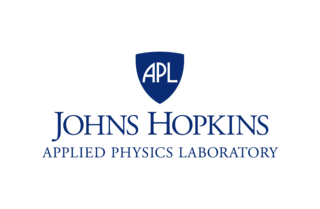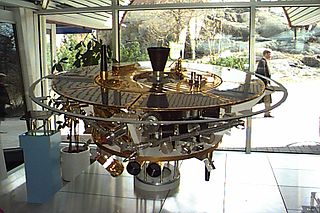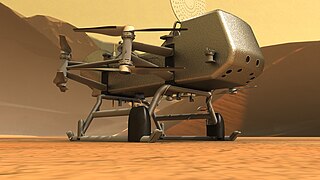Related Research Articles

James Alfred Van Allen was an American space scientist at the University of Iowa. He was instrumental in establishing the field of magnetospheric research in space.

New Horizons is an interplanetary space probe that was launched as a part of NASA's New Frontiers program. Engineered by the Johns Hopkins University Applied Physics Laboratory (APL) and the Southwest Research Institute (SwRI), with a team led by Alan Stern, the spacecraft was launched in 2006 with the primary mission to perform a flyby study of the Pluto system in 2015, and a secondary mission to fly by and study one or more other Kuiper belt objects (KBOs) in the decade to follow, which became a mission to 486958 Arrokoth. It is the fifth space probe to achieve the escape velocity needed to leave the Solar System.

The Johns Hopkins University Applied Physics Laboratory is a not-for-profit university-affiliated research center (UARC) in Howard County, Maryland. It is affiliated with Johns Hopkins University and employs 8,000 people as of 2022. The lab serves as a technical resource for the Department of Defense, NASA, and other government agencies. APL has developed numerous systems and technologies in the areas of air and missile defense, surface and undersea naval warfare, computer security, and space science and spacecraft construction. While APL provides research and engineering services to the government, it is not a traditional defense contractor, as it is a UARC and a division of Johns Hopkins University. APL is a scientific and engineering research and development division, rather than an academic division, of Johns Hopkins.
The Mongoose-V 32-bit microprocessor for spacecraft onboard computer applications is a radiation-hardened and expanded 10–15 MHz version of the MIPS R3000 CPU. Mongoose-V was developed by Synova of Melbourne, Florida, USA, with support from the NASA Goddard Space Flight Center.

FREJA was a Swedish satellite developed by the Swedish Space Corporation on behalf of the Swedish National Space Board. It was piggyback launched on a Long March 2C launch vehicle from Jiuquan Satellite Launch Center in China on October 6, 1992. The satellite's total cost was 19 million U.S. dollars, excluding the costs of experiments.

Michael Ryschkewitsch is the former Space Exploration Sector Head at the Applied Physics Laboratory (APL). He formerly served as the Chief Engineer of the United States National Aeronautics and Space Administration.

The Parker Solar Probe is a NASA space probe launched in 2018 with the mission of making observations of the outer corona of the Sun. It will approach to within 9.86 solar radii from the center of the Sun, and by 2025 will travel, at closest approach, as fast as 690,000 km/h (430,000 mph), or 0.064% the speed of light. It is the fastest object ever built by humans.

Stamatios (Tom) M. Krimizis is a Greek-American scientist in space exploration. He has contributed to many of the United States' unmanned space exploration programs of the Solar System and beyond. He has contributed to exploration missions to almost every planet of the Solar System. In 1999, the International Astronomical Union named the asteroid 8323 Krimigis in his honor.

Robert D. "Rob" Strain is the former Director of NASA's Goddard Space Flight Center. Strain held that post from August 4, 2008, through March 5, 2012. Strain announced in January 2012 that he will retire from NASA and return to private industry.
Nancy Chabot is a planetary scientist at the Johns Hopkins University Applied Physics Laboratory.
Elizabeth "Zibi" Turtle is a planetary scientist at the Johns Hopkins University Applied Physics Laboratory.

486958 Arrokoth (provisional designation 2014 MU69; formerly nicknamed Ultima Thule) is a trans-Neptunian object located in the Kuiper belt. Arrokoth became the farthest and most primitive object in the Solar System visited by a spacecraft when the NASA space probe New Horizons conducted a flyby on 1 January 2019. Arrokoth is a contact binary 36 km (22 mi) long, composed of two planetesimals 21 and 15 km (13 and 9 mi) across, that are joined along their major axes. With an orbital period of about 298 years and a low orbital inclination and eccentricity, Arrokoth is classified as a cold classical Kuiper belt object.
Dr. Robert E. Huffman (1931–2008) was an American space scientist and author. He specialized in ultraviolet spectroscopy in the earth's upper atmosphere. Working for the United States Air Force, Dr. Huffman managed the Horizon Ultraviolet Program (HUP) experiments on two Space Shuttle flights: Columbia and Discovery.

Student Nitric Oxide Explorer, was a NASA small scientific satellite which studied the concentration of nitric oxide in the thermosphere. It was launched in 1998 as part of NASA's Explorer program. The satellite was the first of three missions developed within the Student Explorer Demonstration Initiative (STEDI) program funded by the NASA and managed by the Universities Space Research Association (USRA). STEDI was a pilot program to demonstrate that high-quality space science can be carried out with small, low-cost free-flying satellites on a time scale of two years from go-ahead to launch. The satellite was developed by the University of Colorado Boulder's Laboratory for Atmospheric and Space Physics (LASP) and had met its goals by the time its mission ended with reentry in December 2003.

Dragonfly is a planned spacecraft and NASA mission, which will send a robotic rotorcraft to the surface of Titan, the largest moon of Saturn. It would be the first aircraft on Titan and is intended to make the first powered and fully controlled atmospheric flight on any moon, with the intention of studying prebiotic chemistry and extraterrestrial habitability. It will then use its vertical takeoffs and landings (VTOL) capability to move between exploration sites.

Double Asteroid Redirection Test (DART) was a NASA space mission aimed at testing a method of planetary defense against near-Earth objects (NEOs). It was designed to assess how much a spacecraft impact deflects an asteroid through its transfer of momentum when hitting the asteroid head-on. The selected target asteroid, Dimorphos, is a minor-planet moon of the asteroid Didymos; neither asteroid poses an impact threat to Earth. Launched from Earth on 24 November 2021, the DART spacecraft successfully collided with Dimorphos on 26 September 2022 at 23:14 UTC and shortened its orbit by 32 minutes, greatly in excess of the pre-defined success threshold of 73 seconds. DART's success in deflecting Dimorphos was due to the momentum transfer associated with the recoil of the ejected debris, which was substantially larger than that caused by the impact itself.
NASA's Solar Terrestrial Probes program (STP) is a series of missions focused on study the Sun-Earth system. It is part of NASA's Heliophysics Science Division within the Science Mission Directorate.

Ralph is a science instrument aboard the robotic New Horizons spacecraft, which was launched in 2006. Ralph is a visible and infrared imager and spectrometer to provide maps of relevant astronomical targets based on data from that hardware. Ralph has two major subinstruments, LEISA and MVIC. MVIC stands for Multispectral Visible Imaging Camera and is a color imaging device, while LEISA originally stood for Linear Etalon Imaging Spectral Array and is an infrared imaging spectrometer for spaceflight. LEISA observes 250 discrete wavelengths of infrared light from 1.25 to 2.5 micrometers. MVIC is a pushbroom scanner type of design with seven channels, including red, blue, near-infrared (NIR), and methane.

Nicola J. Fox is the Associate Administrator for NASA's Science Mission Directorate. Appointed to the position in February 2023, she is therefore NASA's head of science. She was previously the Director of NASA's Heliophysics Science Division. Fox was the lead scientist for the Parker Solar Probe, and served as the Science and Operations Coordinator for the International Solar-Terrestrial Physics Science Initiative.

Light Italian CubeSat for Imaging of Asteroids is a six-unit CubeSat of the Italian Space Agency (ASI). LICIACube is a part of the Double Asteroid Redirection Test (DART) mission and carries out observational analysis of the Didymos asteroid binary system after DART's impact on Dimorphos. It communicates directly with Earth, sending back images of the ejecta and plume of DART's impact as well as having done asteroidal study during its flyby of the Didymos system from a distance of 56.7 km (35.2 mi), 165 seconds after DART's impact. LICIACube is the first purely Italian autonomous spacecraft in deep space. Data archiving and processing is managed by the Space Science Data Center (SSDC) of the ASI.
References
- ↑ "Polar Bear Quicklook". space.jpl.nasa.gov. Retrieved 2023-08-14.
- ↑ "NASA - NSSDCA - Polar BEAR". nssdc.gsfc.nasa.gov. Retrieved 2023-08-14.
- ↑ "Satellite Leaves Museum to Fly". New York Times . 1986-07-12. Retrieved 2023-08-14.
- ↑ McCloskey, William (1987). "The Flight of Polar BEAR: A Successful Satellite Program Grows from Parts and Details" (PDF). jhuapl.edu.